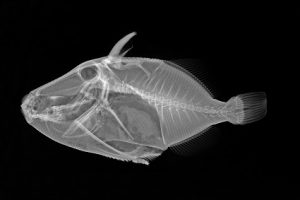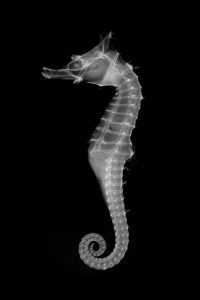Explore a world where art meets science and science gets turned inside out. A traveling exhibition opened Saturday, September 18 at the High Desert Museum. It shares an inside look—literally—into fish and their evolution.

X-Ray Vision: Fish Inside Out, an exhibition from the Smithsonian’s National Museum of Natural History and the Smithsonian Institution Traveling Exhibition Service (SITES), showcases dramatic x-ray prints, exposing the inner workings of the fish in an intersection of science and art.
Fish are vertebrates—animals with backbones—and have bodies supported by a bony skeleton. X-rays document variations in the skeleton, such as the number of vertebrae or the position of fins. The Smithsonian’s National Collection of Fishes X-rays represent more than 70 percent of the world’s fish specimens. It’s the largest and most diverse collection of its kind in the world. Research drove the X-rays featured in the national collection. Yet the strikingly elegant images demonstrate the natural union of science and art. They are a visual retelling of the evolution of fish.
The exhibition features 40 black-and-white digital prints of different species of fish. Arranged in evolutionary sequence, these X-rays give a tour through the long stream of fish evolution. The X-rays have allowed Smithsonian and other scientists to study the skeleton of a fish without altering the specimen. It makes it easier for scientists to build a comprehensive picture of fish diversity.

The curators of the exhibition, Lynne Parenti and Sandra Raredon, have worked in the Division of Fishes at the National Museum of Natural History collecting thousands of X-rays of fish specimens to help ichthyologists understand and document the diversity of fishes. X-rays may also reveal other details of natural history: undigested food or prey in the gut might reveal to an ichthyologist what a fish had for its last meal. The exhibit includes fish that live today in the High Desert.
X-Ray Vision: Fish Inside Out was inspired by the book Ichthyo: The Architecture of Fish (Chronicle Books in association with the Smithsonian Institution, 2008) by Stephanie Comer and Deborah Klochko.
